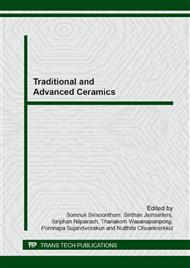p.274
p.280
p.289
p.295
p.301
p.307
p.311
p.316
p.325
Effect of Alumina Source and Soaking Time on Properties of Refractory Mortar Using as Slumping Mold
Abstract:
Slumping molds or sagging molds are utilized for shaping glassware containers and many kinds of slumped glass products from glass plates. In Thailand, a large number of slumped glass factories use such molds in their production because slumping process is easy and cheap; however, the major cost of this process is slumping molds. They are imported from other countries and are expensive. In this research, slumping molds are created from local raw materials using the basic method to reduce the cost of the production. One of proper materials for making slumping mold is refractory mortar which can be easily formed into various shapes and sizes. Consequently, it is interesting to prepare slumping molds from refractory mortar. In this study, the effect of different sources of alumina (calcined alumina and aluminum sludge) and soaking time on the properties of the refractory mortar were investigated. Dolomite clay, milled sand and white portland cement were mixed with sources of alumina in distilled water to form pastes. Super plasticizer was added to the pastes to adjust flow ability. Plastic containers were used as molds for specimen forming. Specimens were cured at room temperature for 24 hours and dried in air for 24 hours. After that specimens were dried in an oven at 110 °C for 24 hours and then fired at 1100 °C. The result showed that the suitable condition for making slumping mold is to use calcined alumina as a source of alumina with soaking temperature of 1100 °C for 4 hours. The physical properties, chemical properties and thermal properties were discussed.
Info:
Periodical:
Pages:
301-306
Citation:
Online since:
April 2014
Keywords:
Price:
Сopyright:
© 2014 Trans Tech Publications Ltd. All Rights Reserved
Share:
Citation:


